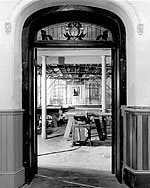Chapel
Restoration
Over the years, the chapel provided benefits to the St. Ann's community, involving those from outside, such as altar boys from St. Louis College and priests from St. Andrew's Cathedral and St. Joseph's Hospital, with their services. The role of the building remained consistent, but the appearance was altered many times. After the structure made the transition from cathedral to chapel, the choir loft was constructed. The interior decoration remained consistent until 1910, at which time the colour scheme was changed to ivory and gold, a transition from the Victorian to the Edwardian period aesthetic. The chapel was well cared for, and received a fresh coat of paint about every ten years.
Click here for more on the restoration of St. Ann's Academy.
The restoration team needed to establish a single period in time to base their work on. A description of the 1921 chapel colour scheme was found, and that discovery, combined with the fact that the 1920s were the most heavily lit years of the chapel's history, led to the decision to return to that era. Stark, Patterson and Associates Heritage Consulting decided on the final finishes. Historic picgraphs, literary references and microscopic analyses of paints and materials contributed to the restoration effort, a project that would bring the chapel back to the community.
The altar, which had been removed after Vatican II, was reconstructed. An original marble plaque was found in the diocesan archives, and was used to help to build the new altar to scale. Red granite "faux-paint" was chosen to finish the altar railing; this railing was returned to its position at the front of the chapel after being absent for over 30 years, due to its removal after Vatican II. The bases of the pillars were marbleized with paint in 1921, and this technique can be seen in the chapel today.
The painted work in the chapel was time consuming, and challenging for the patience required for its painstaking detail. The decision to use gold leaf in the detailing required the covering of over 200 flowers and the ceiling roundels. Hundreds of square metres of 23 karat gilding was labouriously applied. In the words of apprentice painter Cory Williams, it was "nice to be working on something that means so much to the community."
The painting of the ceiling was a very different aspect of the work. The roof could only be sprayed or brushed, for heritage reasons, and it was difficult for the painters to resist the urge to fill in the cracks that had developed in Brother Michaud's once-smooth woodworking. Scaffolding was erected at the level of the choir loft to reach these heights, and the painters, reminded of Michelangelo and the Sistine Chapel ceiling, wittily renamed the trades people "Bartangelo and Donangelo of Saint Ann's".
The pews in the chapel changed several times. A compromise was made in the use of the 1948 pews, as the restoration team had not been able to trace the seating installed in 1886, which would have been the arrangement used during the 1920s. The quest for elements from the chapel and the drive to refinish objects such as the 14 "Stations of the Cross" reliefs continues. Restoration is still ongoing, and the chapel remains "The Heart of St. Ann's."




